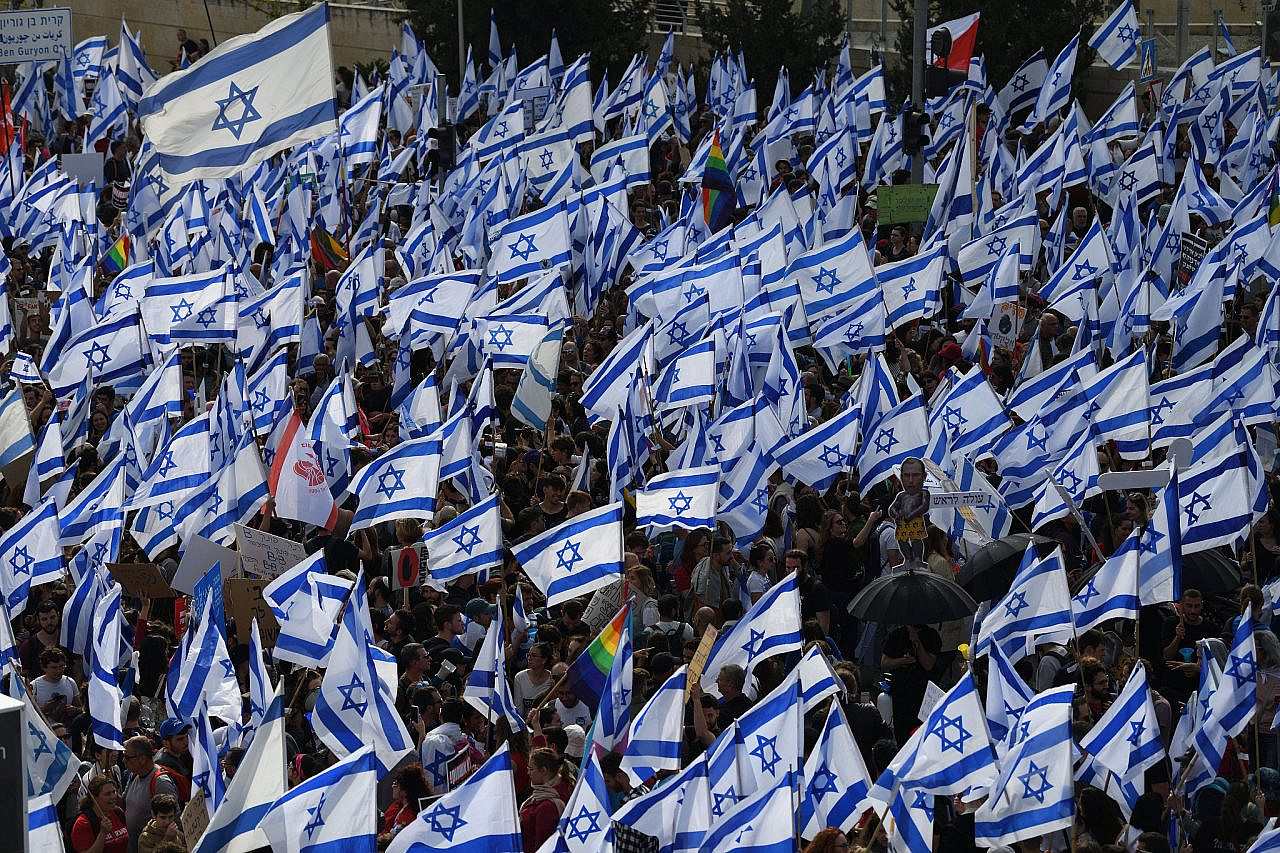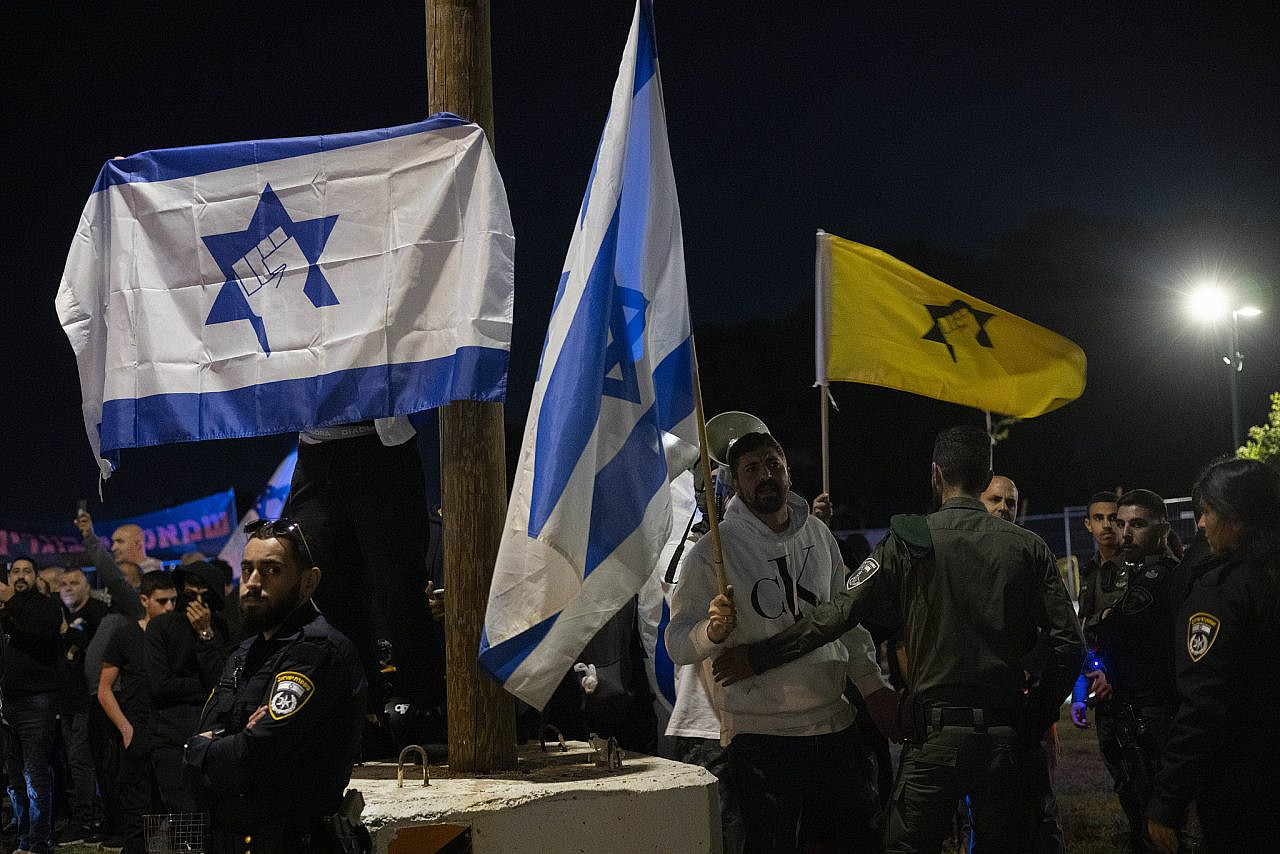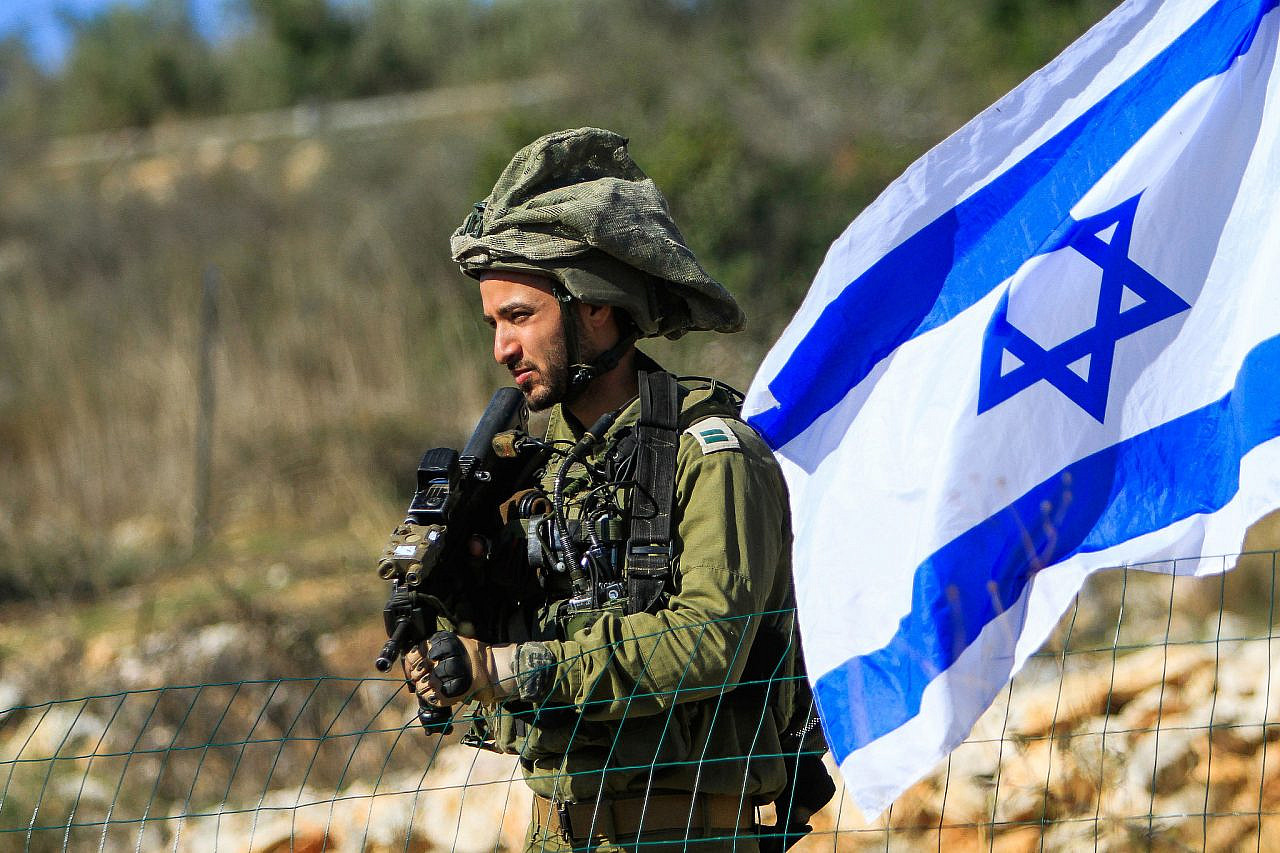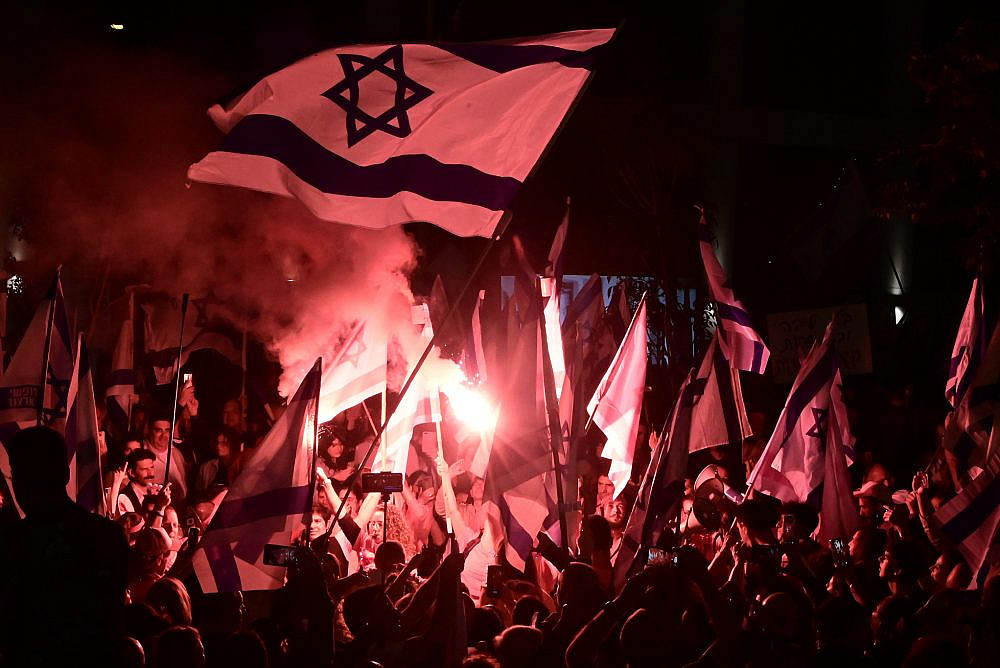This article originally appeared in “The Landline,” +972’s weekly newsletter. Subscribe here.
In the 2011 social justice protests, it was the tent. In the 2020-21 anti-Netanyahu protests, it was the black flag. Now, in the mass demonstrations against the far-right government’s judicial coup, the undisputed symbol is the Israeli flag.
The blue-and-white Star of David flag has, of course, been a regular feature of protests throughout Israel’s history, but there has never been a protest movement so totally dominated by it as we’re seeing now. At the main demonstrations on Tel Aviv’s Kaplan Street, as well as those in front of the Knesset in Jerusalem, the sea of flags has been so large that the organizers have often had to ask protesters to lower them for a few moments in order to allow for aerial photographs of other large banners carried overhead.
It started in early January, when some 30,000 people showed up to a protest in Tel Aviv organized by the Jewish-Palestinian movement Standing Together. Messages against the occupation were prominent, and several participants held Palestinian flags and signs calling for decolonization. After Netanyahu and other right-wing figures used those images to condemn the protest, the next week’s demonstration — organized by more centrist groups — was flooded with Israeli flags.
Since then, organizers have brought tens of thousands of Israeli flags every week to be distributed among the protesters. The intention has been clear from the outset: to deflect the government’s attempt to brand the opposition movement as “leftist,” and to appeal to center-right voters who had previously shied away from protests against Netanyahu.

Shikma Bressler, one of the prominent figures in the protest movement, told +972: “This is a war for the very existence of the State of Israel in its Zionist form. When we know that Israel is at war, we rally behind the flag. The army rallies behind the flag, and [the protesters are] a civil army. It’s not a provocation — the flag does not belong to [the right].”
The flags, most of them made in China, arrive in big boxes to what is called the “bunker” or “factory” in the center of Israel, where they are fitted onto bamboo sticks before being sent to the various protest locations. A donation link appears on the stick, next to the sentence: “Please bring me to all the demonstrations.” Many protesters also bring their own flags from home, but several thousand are still newly distributed each week.
Traditionally, the Israeli flag has been a symbol of right-wing protests. Nowhere is this more evident than at the annual Jerusalem Day Flag March, where thousands of right-wing and religious Israelis march through Damascus Gate and the Muslim Quarter of the Old City with flags, shouting racist slogans at Palestinian residents as they go.
At recent counter-protests in support of the judicial overhaul, right-wingers have still been bringing Israeli flags, but in nowhere near the same numbers as the anti-government protests. For that reason, some right-wingers are instead bringing flags bearing the symbol of Netanyahu’s Likud party, or the outlawed far-right Kach party founded by Rabbi Meir Kahane. At one demonstration, an Israeli flag was seen with the word “transfer” written across it — reflecting support for the population transfer of Palestinians, including those with Israeli citizenship.

The transformation of the Israeli flag into a symbol of “resistance” has also led to some absurd situations in recent weeks. In several cases, private security guards searched for and prevented Israeli flags from being brought into government buildings, or ceremonies and events attended by right-wing politicians, for fear that they would be used to protest the judicial overhaul. One person with a flag was even forbidden by security guards from entering the parking lot of government buildings in Tel Aviv, and was ordered to park elsewhere. The flag has become associated with the “left” to such an extent that people marching with it in the street have even been cursed at by passersby.
Beyond embarrassing the right, however, the decision to flood the anti-government protests with Israeli flags has had more concerning consequences.
The first is the alienation of Palestinians in Israel, who make up 20 percent of the citizenry. The ubiquity of the flag — as well as other national symbols such as the national anthem — is just one clear answer as to why hardly any Palestinian citizens are joining the protests. It shows that the protest leaders are not really interested in including Palestinians in their movement, and that, like opposition MKs Yair Lapid and Benny Gantz, they do not see Arabs as partners in replacing the right-wing government. And while some polls are suggesting that the center-left bloc could be able to form a government without the Arab parties, there is no guarantee that this electoral projection is real or will continue.
The second effect of this flag frenzy is that it creates the impression that Israel is somehow an “ordinary” country — not an occupying state that maintains a regime of Jewish supremacy and metes out violent oppression toward non-Jews on a daily basis. By flying the flag in the name of “democracy,” protesters are not only ignoring the apartheid reality, but are actively participating in its normalization. Even as many participants express sympathy with the anti-apartheid bloc, and others also join it, their weddedness to the Israeli flag shows that they do not recognize the glaring contradictions of their symbol, and how it excludes the Palestinian question from their purported struggle for democracy.

Many of the Israeli protesters want to go back to the status quo ante, before the threat of the judicial coup, while others say they long for real change. That being so, these protestors must ask themselves: what will happen the day after their “victory?” Whether that victory means canceling the judicial overhaul, passing new Basic Laws, or enshrining a constitution — is the society they want to live in one that sanctifies symbols of exclusion, nationalism, and militarism?
The Israeli center left’s revival has been greatly aided by this reclamation and re-appropriation of national symbols, and after years of dormancy and decline, those who identify with the political camp feel they are done ceding ground to the right. The idea that “we are the state” — we are the economy, we are the army, and therefore, the flag is our flag — may work in the short term, but it is the easy road to take. And, as with any addiction, it is difficult to stop. The excitement of many over the Israeli flag’s “new” meaning is sincere, but there is nothing revolutionary, radical, or rebellious about waving it. On the contrary: doing so is an inherently conservative act.
Independence Day was the peak of the veneration of the Israeli flag. But now that this day has passed, it is time to lay down those flags and think about what comes next. Real rebellion requires new symbols that will include everyone, and that symbolize a different future than the one represented by the blue-and-white flag waved on the streets today.


